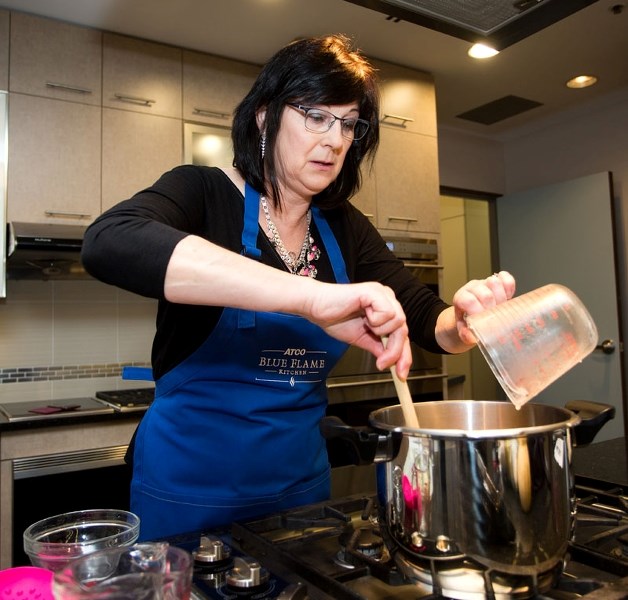As a little kid I was fascinated with our neighbour’s pressure cooker. The heavy pot rattled, clanged and appeared to dance off the stove like a Disney animation.
One day it exploded.
Cool, I thought.
No one was hurt, but the pot was damaged and food splattered on the walls and ceiling of the kitchen making a horrible mess.
My mother was contemplating a purchase, but after the blow-up, nothing could sway her to buy one. She was not alone.
From the 1960s to the 1970s, more than 50 per cent of households in our farming community had a pressure cooker. It was an ideal tool for busy farm wives often squeezed for time.
Pressure cookers do a great job of speeding up cooking time. Water boils at 212 degrees Fahrenheit. However, cookers boost the internal heat to about 240 degrees resulting in faster meal preparation.
By dramatically reducing cooking times, the cooker turns dishes that once required advance planning and long simmering into spur-of-the-moment meals.
In addition to saving time and energy, pressure cookers also seal in flavours and retain more nutrients than conventional methods.
In a cooker, stews are cooked in 45 minutes instead of using the low-and-slow technique that might take two or three hours. Pot roasts are prepared in half the time and dry beans can be rustled up in an hour as opposed to the stovetop method taking several hours.
Once microwaves made their way to department stores in the early 1970s, the kitchen’s once scariest gadget dramatically declined in popularity.
The reasons were many ranging from inexpensive cookers’ poor designs and inferior construction to an exploding food industry flogging short-cut meals such as frozen TV dinners and cake mixes.
However, in the past five years ATCO Blue Flame Kitchen’s economists have noticed a resurgence of interest in this once despised kitchen aid.
“It’s the new ‘it’ appliance,” said Debra Mudryk, ATCO home economist/community educator.
She credits the pressure cookers' surging renaissance to several factors – the slow food movement, cooking shows, social media and the increasing grow-your-own-food trend.
“The most recent resurgence is from TV. People try to do things differently and they look for new recipes and trends. The pressure cooker is a shiny new tool and people love gadgets.”
For many of today’s on-the-go working families, the pressure cooker is a user-friendly gadget.
“A pressure cooker works well for people with a busy lifestyle that like to eat fresh tasty food.”
A big selling point is flavour. Since all the juices and aromatic oils are trapped inside the pot, meats emerge tender and succulent, stews are deliciously thick, and soups and sauces taste as if they have simmered leisurely for several hours.
As she speaks, Mudryk prepares a pressure cooker butternut squash risotto. The cooker takes about five minutes to come up to pressure and an additional eight to cook the risotto. The result is a creamier risotto than a conventionally cooked risotto, but it retains its delicately balanced flavours.
At home Mudryk pulls out her appliance to cook meats, risotto, baked beans, hardy soups and believe it or not, hard-boiled eggs.
“The texture and the colour is nearly ideal. And you can peel them so easily,” said Mudryk.
Pressure cooker shopping
Modern technology produces high-quality models that have multiple layers of safety systems in place. Most have at least two pressure-release devices and a safety lock lid that makes it virtually impossible to open the pot while pressure is occurring inside.
Pressure cookers range in capacity from two-quarts to 20 quarts. Most families find a six or eight-quart cooker ideal.
While older cookers were constructed of aluminum, the metal of choice today is stainless steel.
“You want a pressure cooker with a heavy bottom – stainless steel with an aluminum or copper layer to retain heat,” Mudryk said.
Cookers should be loaded no more than two-thirds filled with ingredients and water. While almost any type of food can be prepared in a cooker, some brands discourage cooking small seeds like millet, kasha and cracked wheat as it may block the steam vents.
“You have to read your manual. Some foods like beans and grains expand and you don’t want them to plug your release valve if there is too much pressure.”
Avoiding a pressure cooker explosion is as simple as making sure the lid is locked on properly and the multiple pressure release valves are not clogged.
ATCO Blue Flame Kitchen offers a Cooking Under Pressure class under their Learn at Lunch program. The class is $15 and runs Friday, Jan. 22 from 11:45 a.m. to 12:45 p.m. For more information call 1-877-420-9090 or go online to atcoblueflamekitchen.com.




